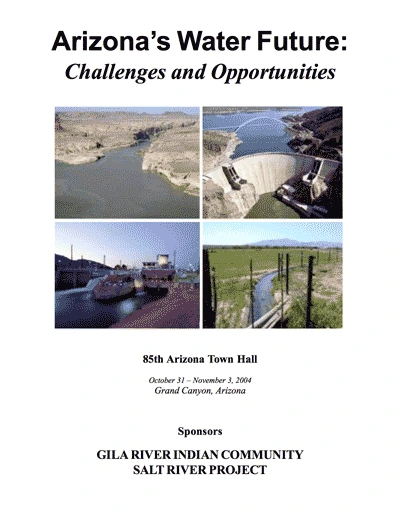
In 1997, I attended my first Arizona Town Hall. The topic was water. This fall, I had the privilege of attending the 85th Town Hall, entitled “Arizona’s Water Future: Challenges and Opportunities,” in a dual role. Because I served as one of the authors of the background research report, I served as a resource consultant to one of the panels. But I also was a participant involved in the panel’s discussions and deliberations. This was the largest Town Hall ever. Almost 180 people participated. It was a stimulating few days!
To me, there were some marked differences between the atmosphere of this most recent Town Hall and the one several years ago. Seven years ago, a major concern was the formation of new Active Management Areas. I recall the strength of the opposition to the concept of extending state regulation of groundwater beyond existing AMA boundaries. The 1997 Town Hall was very clear on this. The Report concluded that “the AMA model is not the appropriate mechanism for local problem-solving and development of longterm water planning.” The recent Town Hall accepted this conclusion as a given. The focus this time was more on how to meet the informational and financial needs of local and regional efforts to develop and implement water resource plans.
In 1997, the Arizona Department of Environmental Quality was beset by difficulties and its viability as a state water agency was questioned. The report recommended “consideration be given to merging some of ADEQ’s water quality programs into ADWR to ensure continuity in water management. ... One agency should be responsible for coordinating and managing water quantity and quality.” Now on firmer ground, ADEQ wasn’t focused on this year.
Instead, the importance of providing resources to enable the Arizona Department of Water Resources to carry out a much-expanded mission was the focus of much discussion. The importance of this issue can be gauged from a motion unanimously adopted during the plenary session: “The primary recommendation from this Town Hall is that dedicated and secure funding sources be created to finance Arizona’s critical water management, planning and infrastructure needs. Without such secure funding, the other recommendations of this report are not achievable.”
Other recommendations included that ADWR be responsible for collecting and disseminating information about water supplies and demand, particularly in non-AMA areas. It was also concluded that ADWR should be responsible for coordinating long-range, statewide water planning. The report stated: “ADWR must play a central leadership and advocacy role. The Agency’s statewide mission should be expanded and strengthened in the areas of policy development, planning and data collection. ADWR’s strategic plan should be implemented by local policymakers on a regional basis. Town Hall recommends that a primary objective in any planning process is for ADWR to collect comprehensive hydrologic data on all Arizona water resources, including water quality in conjunction with ADEQ, and disseminate such information throughout the state. It also should lead in the statewide conservation campaign.”
Town Hall’s front-and-center attention to ADWR is appropriate. The state agency would be responsible for carrying out many of the recommendations, if implemented. Fulfilling these new functions would require considerable financial resources and talent, and the agency already is in financial straits, unable perform its current mission. The Town Hall recommended that ADWR receive additional resources to help it meet the challenge of assisting in the resolution of Arizona’s current and future water challenges.
In addition to increased general fund appropriations, it was recommended that “costs caused by growth should be funded by growth” and new funding mechanisms be explored. The funding mechanisms specifically mentioned included bonding (which is really a method of financing), exempt well fees, federal programs such as Water 2025, surcharges, permit and impact fees, private sector donations coupled with tax credits or deductions, property taxes, and user taxes. This is quite an inclusive list, but perhaps the most important part of the primary recommendation is the inclusion of the word “secure.” This acknowledges that it would not do much good if increased revenues generated by new funding sources were used to replace existing general fund revenues.
The serious drought conditions and their implications were covered in the Town Hall background report and reflected in the report adopted at the closing plenary session. Although continuing to grow at a rapid pace, many of the state’s communities have not quantified the water resources needed for expected growth. Town Hall participants questioned whether the general public understands the critical nature of Arizona’s water issues. The Report stated, “In the short term, all Arizonans must be educated about the severity of the [drought] issue, supply limitations and potential solutions.” The Town Hall called for increased water literacy.
The importance of education at all levels was highlighted, with the report emphasizing development of a conservation ethic and recommending that Arizona “take a national leadership role in developing and implementing a new K-12 conservation curriculum that is aligned to the state educational standards.” We at the Water Resources Research Center already are assuming a leadership role. Arizona Project WET, as well as other programs and individuals, have been working on aligning water resource curricula with state standards. We can attest to strong community and water company support for conservation and general water stewardship curricula. Additional resources will enable us to train teachers to integrate water into their instruction and generate the financial resources to support delivery of water education to all Arizona schools.
This was the fifth Arizona Town Hall to address water issues. Let’s see if we can resolve some of these critical water issues prior to the sixth. We have our work cut out for us!

